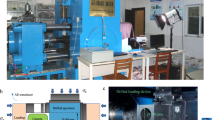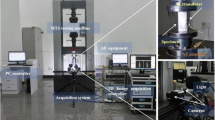Abstract
The purpose of the study was to compare stress values obtained from Acoustic Emission and Compact Conical-Ended Borehole Overcoring stress measurement techniques applied at an underground limestone mine in Japan, and to investigate the effect of rock anisotropy and confining pressure on the Kaiser Effect level which has been used to determine in situ stresses by the Acoustic Emission technique. Initially, Acoustic Emission tests were carried out on limestone cores extracted from horizontal boreholes in a pillar and hanging wall in the underground mine. The stress values obtained were two or three times greater than those obtained by the Compact Conical-Ended Borehole Overcoring method. In the second stage, the anisotropy of a granite block was determined by P-wave measurements. Core specimens extracted from two different directions were pre-loaded under axisymetric triaxial conditions by applying a series of differential stresses. The cores were then re-loaded under uniaxial conditions and the Kaiser Effect levels were determined. It was concluded that both the anisotropy and confining pressure have an important influence on the Kaiser Effect level.
Résumé
Le but de l’étude était de comparer les valeurs de contraintes obtenues à partir de la technique de mesure par Emission acoustique (AE) et une technique de Sur-carottage (CCBO), mises en œuvre dans une mine souterraine de calcaire au Japon. De plus, les effets de l’anisotropie de la roche et de la pression de confinement sur l’effet Kaiser défini dans les techniques d’émission acoustique ont été étudiés. Initialement les essais d’émission acoustique ont été réalisés sur des carottes de calcaire issues de forages horizontaux réalisés dans un pilier et une couche de toit de la mine souterraine. Les valeurs de contraintes obtenues étaient deux ou trois fois plus grandes que celles obtenues par la méthode de sur-carottage. Dans une deuxième étape, l’anisotropie d’un bloc de granite a été déterminée par des mesures de vitesses d’ondes P. Des échantillons carottés suivant deux directions différentes furent pré-chargés sous conditions triaxiales symétriques en appliquant différents niveaux de contraintes. Les échantillons furent re-chargés sous conditions uni-axiales et les valeurs d’effet Kaiser déterminées. On a conclu que l’anisotropie et la pression de confinement avaient tous deux une influence importante sur les valeurs d’effet Kaiser.











Similar content being viewed by others
References
Barr SP, Jupe A, Hunt DP (1999) The Kaiser Effect for samples pre-stressed at 820 m and 2.4 km with stress tensor results. In: Vouille G, Berest P (eds) Proceedings of the ISRM international congress on rock mechanics, Paris, vol 2, pp 1133–1136
Diederichs MS, Kaiser PK, Eberhardt E (2004) Damage initiation and propagation in hard rock during tunneling and the influence of near-face stress rotation. Int J Rock Mech Mining Sci 41(5):785–812
Eberhardt E, Stead D, Stimpson B, Read RS (1998) Identifying crack initiation and propagation thresholds in brittle rock. Can Geotech J 35:222–233
Filimonov YL, Lavrov AV, Shafarenko YM, Shkuratnik VL (2001) Memory effects in rock salt under triaxial stress state and their use for stress measurement in a rock mass. Rock Mech Rock Eng 34(4):275–291
Hardy HR Jr, Zhang D, Zelanko JC (1989) Recent studies of the Kaiser Effect in geologic materials. In: Proceedings of the 4th conference on acoustic emission/microseismic activity in geologic structures and materials. Trans. Tech. Publications, State College, pp 27–55
Hayashi M, Kanagawa T, Hibino S, Motozima M, Kitahara Y (1979) Detection of anisotropic geo-stresses trying by acoustic emission, and non-linear rock mechanics on large excavating caverns. In: Proceedings of the 4th ISRM international congress on rock mechanics. Montreux 2:211–218
Holcomb DJ (1993) General theory of the Kaiser Effect. Int J Rock Mech Mining Sci Geomech Abst 30(7):929–935
Hughson DR, Crawhord AM (1987) Kaiser Effect gauging: the influence of confining stress on its response. In: Proceedings of the 6th ISRM international congress on rock mechanics, Montreal, pp 981–985
Ishiguro Y, Nishino K, Murakami A, Sugawara K, Kawamoto T (1999) In situ initial rock stress measurement and design of deep underground powerhouse cavern. In: Proceedings of the 9th ISRM international congress on rock mechanics. pp 1155–1158
ISRM (2007) The complete ISRM suggested methods for rock characterization, testing and monitoring: 1974–2006. In: Ulusay R, Hudson JA (eds) Suggested methods prepared by the commission on testing methods, ISRM, compilation arranged by the ISRM Turkish National Group, Kozan ofset, Ankara
Jingen D, Kangping W, Rongzun H (1995) In situ stress determination at great depth by using acoustic emission. In: Proceedings of the 35th U.S. symposium on rock mechanics. Reno, pp 245–250
Jupe AJ, Barr SP, Pine RJ (1992) In situ stress measurements obtained using overcoring and the Kaiser Effect of acoustic emissions within the Carnmenellis granite. In: Proceedings of the 11th international acoustic emission symposium, progress in acoustic emission VI. Fukuoka, The Japanese Society for Non-Destructive Inspection, pp 167– 174
Kaiser J (1953) Erkenntnisse und Folgerungen aus der Messung von Geräuschen bei Zugbeanspruchung von metallischen Werkstoffen. Archiv Eisenhüttenwesen 24(1/2):43–45
Kanagawa T, Hayashi M, Nakasa H (1976) Estimation of special geo-stress components in rock samples using the Kaiser Effect of acoustic emission. Technical report, C.R.I.E.P.I., E375004 (in Japanese)
Lavrov A (2003) The Kaiser Effect in rocks: principles and stress estimation techniques. Int J Rock Mech Mining Sci 40:151–171
Momayez M, Hassani FP (1992) Application of Kaiser Effect to measure in situ stresses in underground mines. In: Proceedings of the 33rd US Symposium, Rock Mechanics. A.A. Balkema, pp 979–988
Nara Y, Kaneko K (2006) Sub-critical crack growth in anisotropic rock. Int J Rock Mech Mining Sci 43:437–453
Obara Y, Sakaguchi, T. Nakayama T, Sugawara K (1992) Anisotropy effect on fracture toughness of rock. In: Proceedings of Eurock’92. Thomas Telford, pp 7–12
Park P, Park N, Hong C, Jeon S (2001) The influence of delay time and confining pressure on in situ stress measurement using AE and DRA. In: Proceedings of the 38th US symposium, rock mechanics in the national interest. Swets & Zeitlinger Lisse, pp 1281–1284
Sano O, Kudo Y, Mizuta Y (1992) Experimental determination of elastic constants of Oshima granite, Barre granite, and Chelmsford granite. J Geophys Res 97(B3):3367–3379
Seto M, Utagawa M, Katsuyama K (1992) The estimation of pre-stress from AE in cyclic loading of pre-stressed rock. In: Proceedings of the 11th international acoustic emission symposium, progress in acoustic emission VI. Fukuoka, The Japanese Society for Non-Destructive Inspection, pp 159–166
Seto M, Nag DK, Vutukuri VS (1999) In situ rock stress measurement from rock cores using the acoustic emission method and deformation rate analysis. Geotech Geol Eng 17:241–266
Shen W (1995) Objective Kaiser stress evaluation in rock. In: Proceedings of the 5th conference on acoustic emission/microseismic activity in geologic structures and materials. Trans Tech Publications, State College, pp 177–195
Stuart CE, Meredith PG, Murrell SAF (1995) Van Munster H. Influence of anisotropic crack damage development on the Kaiser Effect under true triaxial stress conditions. In: Proceedings of the 5th conference on acoustic emission/microseismic activity in geologic structures and materials. Trans Tech Publications, State College, pp 206–219
Sugawara K, Obara Y (1999) Draft ISRM suggested method for in situ stress measurement using the compact conical-ended borehole overcoring(CCBO) technique. Int J Rock Mech Min Sci Geomech Abstr 36:307–322
Tuncay E (2006) An investigation on the applicability of the acoustic emission technique to determine in situ stresses. PhD Thesis. Ankara. Hacettepe University, Dept. of Geological Engineering, pp 206 (in Turkish)
Tuncay E, Ulusay R (2008) Relation between Kaiser Effect levels and pre-stresses applied in the laboratory. Int J Rock Mech Mining Sci 45(4):524–537
Ulusay R, Tuncay E, Watanabe H, Tano H, Aydan O (2003) The measurement of the stress state of Turkey by Acoustic Emission (AE) method. In: Proceedings of the 3rd ınternational symposium on rock stress, RS KUMAMOTO ‘03. Kumamoto, Japan, pp 255–260
Villaescusa E, Seto M, Baird G (2002) Stress measurements from oriented core. Int J Rock Mech Mining Sci 39(5):603–615
Villaescusa E, Li J, Windsor CR, Seto M (2006) A comparison of overcoring and AE stress profiles with depth in Western Australian mines. In: Proceedings of international conference on in-situ rock stress, Taylor & Francis Group, Trondheim, pp 223–228
Wang HT, Xian XF, Yin GZ, Xu J (2000) A new method of determining geostresses by the acoustic emission Kaiser Effect. Int J Rock Mech Mining Sci 37:543–547
Watanabe H, Tano H, Akatsu T (1994) Fundamental study on pre-stress measurement of triaxial compressed rock. J College Eng Nihon Univ 35(A):11–19 (in Japanese)
Watanabe H, Tano H, Ulusay R, Yüzer E, Erdogan M, Aydan O (1999) The initial stress state in Cappadocia. In: Proceedings of the ‘99 Japan–Korea joint symposium on rock engineering, pp 249–260
Windsor CR, Cavieres P, Villaescusa E, Pereira J (2006) Rock stress tensor measurements at El Teniente Mine, Chile. In: Proceeding of international confernce in situ rock stress, Taylor & Francis Group, Trondheim, pp 67–72
Acknowledgments
The authors are grateful to Mr. T. Nakazono for his kind support during the laboratory studies.
Author information
Authors and Affiliations
Corresponding author
Rights and permissions
About this article
Cite this article
Tuncay, E., Obara, Y. Comparison of stresses obtained from Acoustic Emission and Compact Conical-Ended Borehole Overcoring techniques and an evaluation of the Kaiser Effect level. Bull Eng Geol Environ 71, 367–377 (2012). https://doi.org/10.1007/s10064-011-0362-y
Received:
Accepted:
Published:
Issue Date:
DOI: https://doi.org/10.1007/s10064-011-0362-y
Keywords
- Acoustic Emission (AE)
- Compact Conical-ended Borehole Overcoring (CCBO)
- Kaiser Effect (KE)
- Rock anisotropy
- Rock stress




